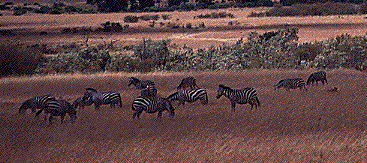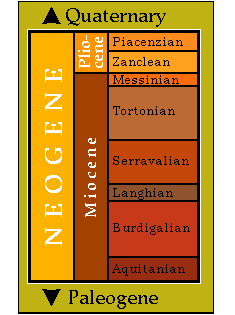
The picture below shows a modern herd of zebra grazing on an African savanna. Grazing mammals, such as members of the perissodactyl and artiodactyls diversified in the Miocene and Pliocene as grasslands and savanna spread across most continents.

The Pliocene was a time of global cooling after the warmer Miocene. The cooling and drying of the global environment may have contributed to the enormous spread of grasslands and savannas during this time. The change in vegetation undoubtedly was a major factor in the rise of long-legged grazers who came to live in these areas.
Additionally, the Panamanian land-bridge between North and South America appeared during the Pliocene, allowing migrations of plants and animals into new habitats. Of even greater impact was the accumulation of ice at the poles, which would lead to the extinction of most species living there, as well as the advance of glaciers and ice ages of the Late Pliocene and the following Pleistocene.
 |
Pliocene: The chart at left shows the major subdivisions of the Neogene, the last portion of the Tertiary Period, including the Pliocene. You may click anywhere on the other Epoch (Miocene) or the arrows to navigate to those exhibits. The Pliocene Epoch is part of the Cenozoic Era. |
Get a quick background to the Pliocene from Jonathan Adams at the Oak Ridge National Laboratory.
View a model of Pliocene global climate by Mark A. Chandler at NASA.
The USGS Global Change Program has Pliocene climate change information in their Pliocene Research program PRISM.
Find out more about the Tertiary paleontology and geology of North America at the Paleontology Portal.


